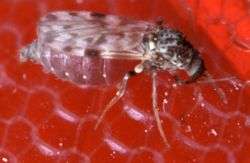Midge
A midge is any small fly, including species in several families of non-mosquito Nematoceran Diptera. Midges are found (seasonally or otherwise) on practically every land area outside permanently arid deserts and the frigid zones. Some midges, such as many Phlebotominae (sand fly) and Simuliidae (black fly), are vectors of various diseases. Many others play useful roles as prey items for insectivores, such as various frogs and swallows. Others are important as detritivores, participating in various nutrient cycles. The habits of midges vary greatly from species to species, though within any particular family, midges commonly have similar ecological roles.
| Look up midge in Wiktionary, the free dictionary. |
| Midges | |
|---|---|
 | |
| A biting midge feeding on blood through an artificial membrane for insect rearing | |
| Scientific classification | |
| Kingdom: | |
| Phylum: | |
| Class: | |
| Order: | |
| Suborder: | |
Examples of families that include species of midges include:[1]
- Blephariceridae, net-winged midges
- Cecidomyiidae, gall midges
- Ceratopogonidae, biting midges (also known as no-see-ums or punkies in North America, and sandflies[2] in Australia)
- Chaoboridae, phantom midges
- Chironomidae, non-biting midges (also known as muckleheads[3], muffleheads[4] or lake flies[5] in the Great Lakes region of North America)
- Deuterophlebiidae, mountain midges
- Dixidae, meniscus midges
- Scatopsidae, dung midges
- Thaumaleidae, solitary midges
Examples
The Ceratopogonidae (biting midges) include serious blood-sucking pests, feeding both on humans and other mammals. Some of them spread the livestock diseases blue tongue and African horse sickness – other species though, are at least partly nectar feeders, and some even suck insect bodily fluids.[6]
Most other midge families are bloodsuckers, but it is not possible to generalise rigidly because of the vagueness of the term "midge". There is, for example, no objective basis for excluding the Psychodidae from the list, and some of them (or midge-like taxa commonly included in the family, such as Phlebotomus) are blood-sucking pests and disease vectors.
Most midges, apart from the gall midges (Cecidomyiidae), are aquatic during the larval stage. Some Cecidomyiidae (e.g., the sorghum midge) are significant plant pests. The larvae of some Chironomidae contain haemoglobin and are sometimes referred to as bloodworms.[7]
Non-biting midge flies are a common minor nuisance around man-made bodies of water.[8]
One type of midge (a type of fly in the family Dipteran) is a major pollinator of Theobroma cacao (cocoa tree) because of its unique morphological and behavioral characteristics. Having natural pollinators has beneficial effects in both agricultural and biological products because it increases Theobroma cacao crop yield and also density of predators of the midges (still beneficial to all parties).[9]
See also
References
- Merritt, R. W.; Cummins, K. W., eds. (1996). An Introduction to the Aquatic Insects of North America. Kendall/Hunt Publishing Company.
- "Archived copy" (PDF). Archived from the original (PDF) on 2015-01-22. Retrieved 2015-01-22.CS1 maint: archived copy as title (link)
- "Bug invasion! Muckleheads caught on radar swarming back to NE Ohio". fox8.com. 2018-06-04. Retrieved 2018-06-05.
- "What exactly are all these pesky midges? Entertaining video on the insects that swarm Lake Erie". cleveland.com. Retrieved 2018-06-05.
- "Why you should never smash lake flies and other facts about the annual Lake Winnebago insect hatch". Appleton Post Crescent. Retrieved 2020-07-15.
- Weaving, Alan; Picker, Mike; Griffiths, Charles Llewellyn (2003). Field Guide to Insects of South Africa. New Holland Publishers, Ltd. ISBN 1-86872-713-0.
- Walker, Ian R. (2001). "Midges: Chironomidae and related Diptera". In Smol, J. P.; Birks, H. J. B.; Last, W. M. (eds.). Tracking Environmental Change Using Lake Sediments. Developments in Paleoenvironmental Research. 4: Zoological Indicators. Dordrecht, The Netherlands: Kluwer Academic Publishers. pp. 43–66. doi:10.1007/0-306-47671-1_3. ISBN 978-0-306-47671-6.
- Apperson, Charles; Waldvogel, Michael; Bambara, Stephen (2006). "Biology and Control of Non-biting Aquatic Midges". Department of Entomology, North Carolina Cooperative Extension.
- Forbes, Samantha J.; Northfield, Tobin D. (2016-12-26). "Increased pollinator habitat enhances cacao fruit set and predator conservation". Ecological Applications. Ecological Society of America. 27 (3): 887–899. doi:10.1002/eap.1491. ISSN 1051-0761. PMID 28019052.